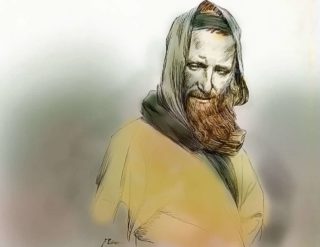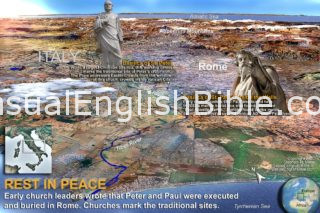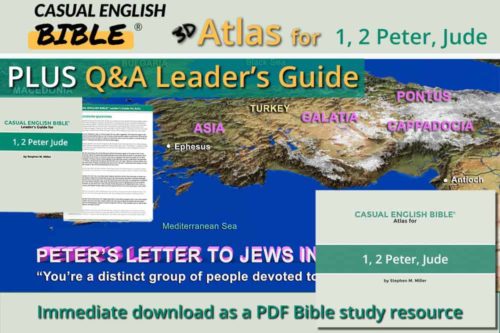
1 Peter. Some scholars say this seems like an odd book for Peter to write. Peter addresses Christians scattered throughout what is now Turkey. That was Paul’s turf. Paul was born and raised there, and that’s where Paul started planting churches among non-Jews. There’s no record of Peter ever having gone there. He’s best known for ministering to Jews in what is now Israel and Palestinian Territories. One guess about why he wrote is that he was on trial in Rome, just before his crucifixion, when he got word that churches throughout Turkey were facing some kind of persecution, which Peter never identified. Emperor Nero, credited with executing Peter and Paul, launched the first persecution of Christians after accusing them of starting the July AD 64 fire that burned much of Rome. That might explain why Peter, on trial in Rome, wouldn’t specifically identify Nero as the source of the trouble. But there are other theories too. Jews might have caused the trouble for these churches, as they had done for Turkey’s premiere church planter, Paul.
2 Peter. Frauds in the church were apparently one of the main reasons Peter or someone writing in his name sent this open letter to Christians everywhere. The frauds apparently tried to pass themselves off as church leaders. But they were greedy people who wanted to get rich off the church. Driven by their animal instincts, they taught heresy that advocated sexual immorality. “These people act like animals. . . . They’ll die like those animals too” (2 Peter 2:12). In addition to warning Christians about these frauds, he told them not to worry about why Jesus hadn’t come back yet. Critics apparently were targeting this promise of a Second Coming, perhaps a generation or more after Jesus seemed to say he’d be back before his generation ended. “I’m telling you the truth, this generation of human beings will live to see everything I’ve talked about here” (Mark 13:30). Peter explains, “Our leader isn’t late, as some claim. He didn’t break his promise. Instead, he’s being patient with you. He doesn’t want anyone annihilated. He wants everyone to reject sin instead of rejecting him” (2 Peter 3:9).
Jude. This is a one-chapter book warning Christians about fraudulent church leaders preaching heresy and practicing what they preach. “Some people snuck into your church. These are bad people, condemned long before their time. They take God’s kindness and misrepresent it. They treat it as a license to behave immorally and to reject our only true leader and Lord, Jesus Christ” (Jude 1:4). Sounding a bit like 2 Peter, Jude says they operate on animal instincts that “will destroy them” (Jude 1:10). He urges believers to hold on to the truth the apostles taught them and trust that “God can keep you from falling” (Jude 1:24).
Writers
1 Peter. This letter was written in a polished style of Greek, which is a tad surprising for a fisherman Jerusalem Jews described as uneducated: “Bold talk coming out of Peter and John shocked the council since it was obvious that both men were uneducated” (Acts 4:13). Peter, like many people of his day, often used the services of people who knew how to write well. We do much the same today when we hire lawyers to write contracts and other formal documents. Peter, in fact, says that’s what he did: “Silas, a devoted brother in Christ, helped me write and deliver this short letter to you” (1 Peter 5:12). This may have been the same Silas who helped Paul plant churches throughout Turkey and who helped Paul write the letters of 1 and 2 Thessalonians. Church leaders writing in the AD 90s and 100s say Peter wrote this letter.
2 Peter. This letter is signed from “Simon Peter, . . . an apostle of Jesus Christ” (2 Peter 1:1). But there are two main reasons some scholars say someone else wrote the letter in Peter’s name, perhaps to honor him. The letter seems to address problems that didn’t develop until late into the first century and into the second, long after Peter likely died in the mid-60s. Also, the writer stamps the letters of Paul as “sacred writings” (2 Peter 3:16), “Scriptures” in some translations (New American Standard Bible, New Century Version). Scholars who say Peter wrote the letter say the problems he addressed were the beginnings of problems that blew up later in the church. As for Paul’s letters tagged as scripture, he had been writing more than a dozen years by the time he and Peter died, long enough for the Christian movement to recognize God’s inspiration in those words.
Jude. The writer identifies himself as “Jude, a worker for Jesus Christ and a brother of James” (Jude 1:1). Jude, a nickname for Judas, may have been one of the brothers of Jesus: “James, Joseph, Simon, and Judas” (Matthew 13:55). James became the leader of the Jerusalem congregation, and he seemed to chair the first council meeting of the Christian movement. He made the closing statement at that meeting (Acts 15:13). Jewish historian Josephus (AD 37 to about AD 100) said Jerusalem Jewish leaders stoned James shortly before Jews rebelled against Rome in AD 66—a rebellion the Roman army crushed.
Timeline
1 Peter. Peter died in the AD mid-60s. Some scholars say Peter may have written this letter sometime between July AD 64, when Rome burned in a fire Nero blamed on Christians, and AD 68, when Nero committed suicide. During that stretch, Jews rebelled against Rome and temporarily ran them out of the country. Rome’s army returned in force, recapturing the country and destroying Jerusalem and the Jewish Temple, which has never been rebuilt.
2 Peter. If Peter wrote this letter, he did it sometime before Emperor Nero committed suicide in AD 68. Early church writers say Peter and Paul died in Rome during Nero’s persecution of Christians after he accused them of starting the July AD 64 fire that burned much of Rome to the ground.
Jude. Jude and 2 Peter sound so much alike that many scholars say they were probably written about the same time.
 Location
Location
1 Peter. Peter uses the code name of “Babylon” to describe the city from which he’s writing (1 Peter 5:13, New American Standard Bible). “Babylon” is code for Rome because Rome conquered the Jewish homeland. Later, in AD 70, Rome would do something else Babylon did: level Jerusalem and its Temple.
2 Peter. Peter doesn’t say where he was at the time. Rome is one guess because he says he’s about to die soon. “It won’t be much longer. My body is going to get set aside” (2 Peter 1:14). So he may have been writing from Rome, where he was crucified.
Jude. Jude doesn’t say where he is when he’s writing this open letter to believers everywhere. He may have remained in his family’s hometown of Nazareth, though the locals initially didn’t take kindly to Jesus. They wanted to “toss him over the cliff” (Luke 4:29). He might have continued Jesus’s work in the fishing village Jesus used as his headquarters: Capernaum. Jude’s brother James seems to have been the leader of the Jerusalem church, until Jewish leaders there stoned him to death for teaching what they considered heresy.
Destination of Letters
1 Peter. Peter writes to “Jews scattered abroad, north of Israel in the Roman provinces of Pontus, Galatia, Cappadocia, Asia, and Bithynia” (1 Peter 1:1). That territory in Turkey covers about a quarter of a million square miles, roughly the size of Texas. Peter doesn’t say “Jews.” He literally says “refugees of the dispersion,” a technical phrase referring to Jews living outside the traditional Jewish homeland of what is now Israel and Palestinian Territories.
2 Peter. Peter addresses his letter to all Christians everywhere: “Everyone with a faith that’s as precious as mine” (2 Peter 1:1).
Jude. Jude addresses this letter to “everyone who accepted God’s invitation, is loved by God the Father, and is being kept safe for Jesus Christ’s return” (Jude 1:1).





